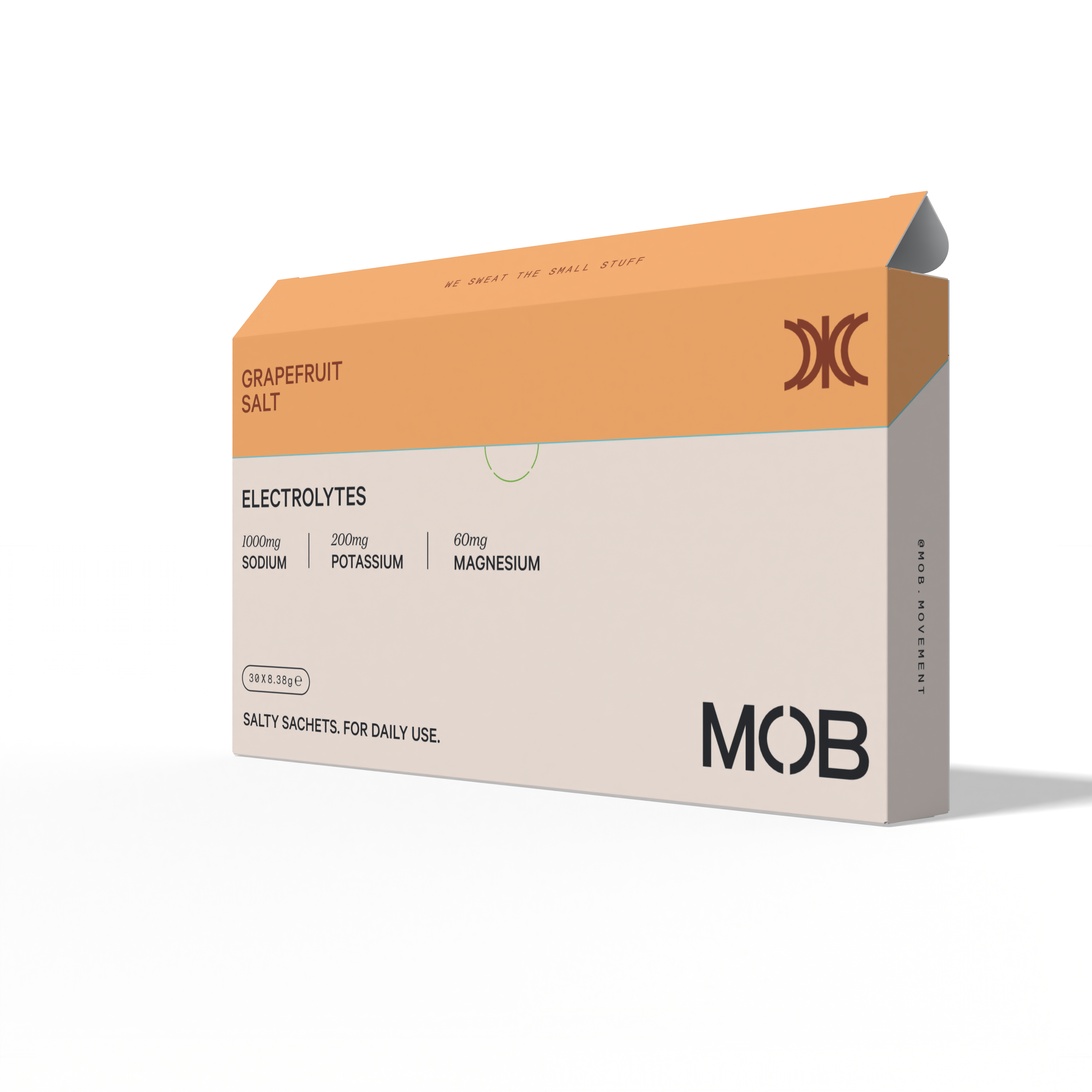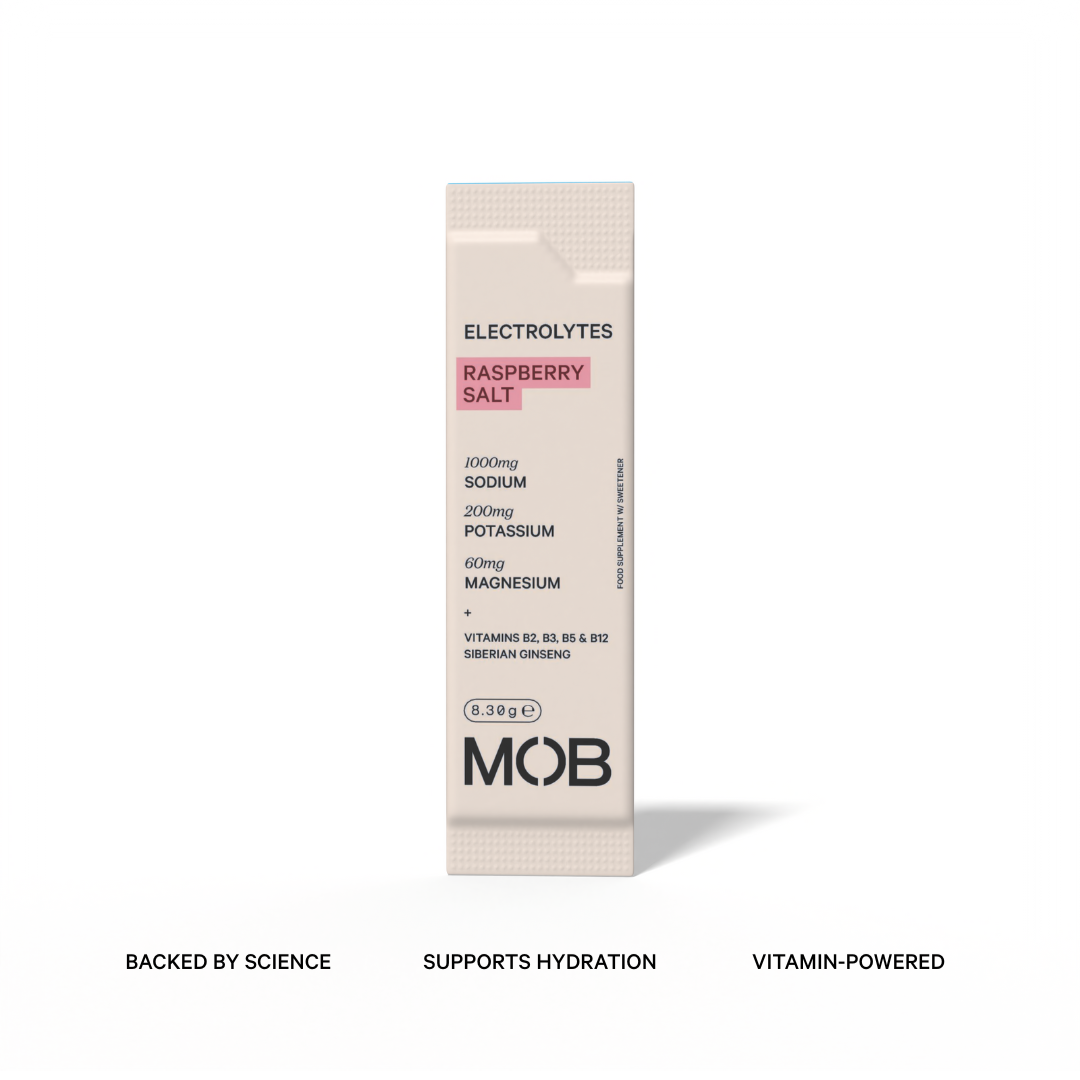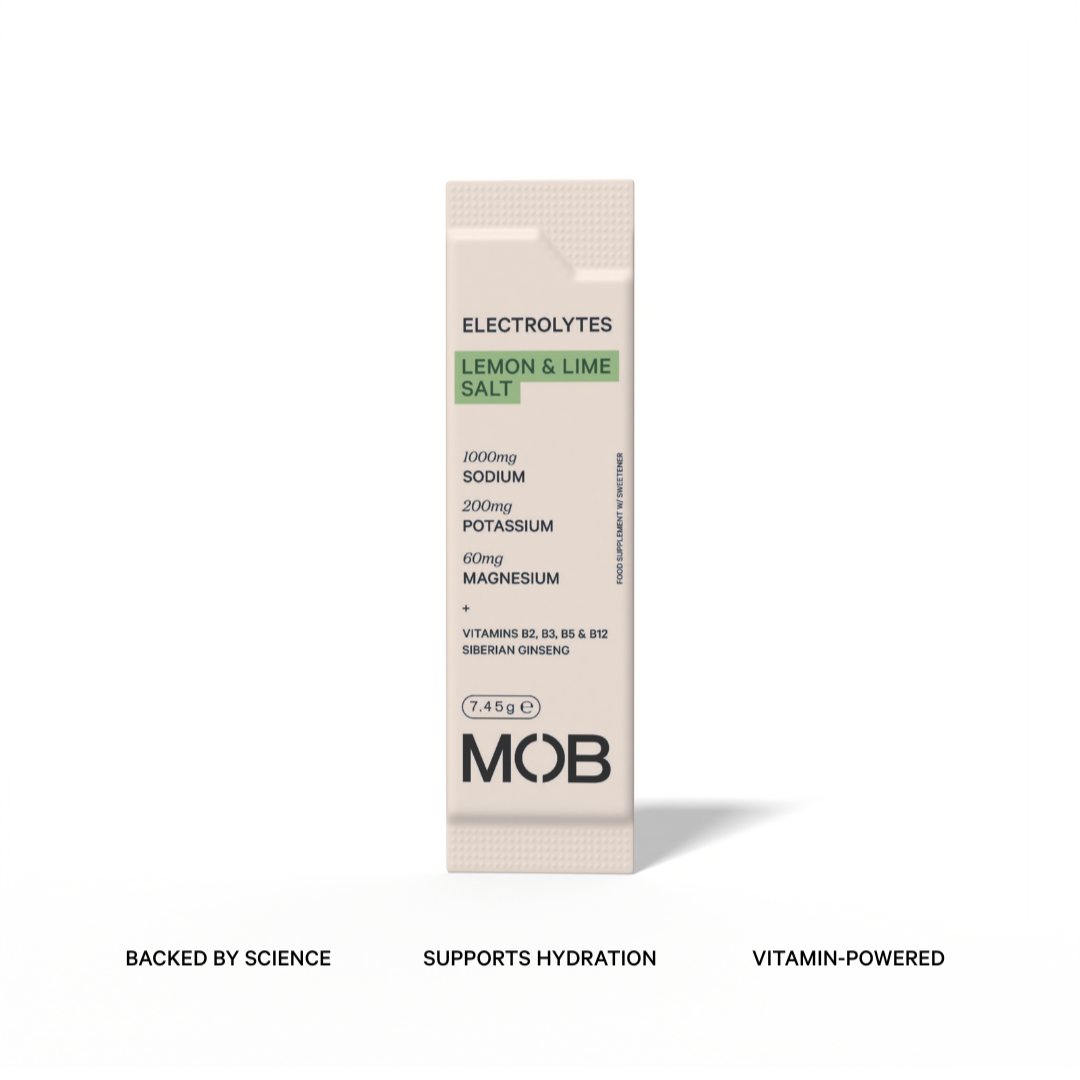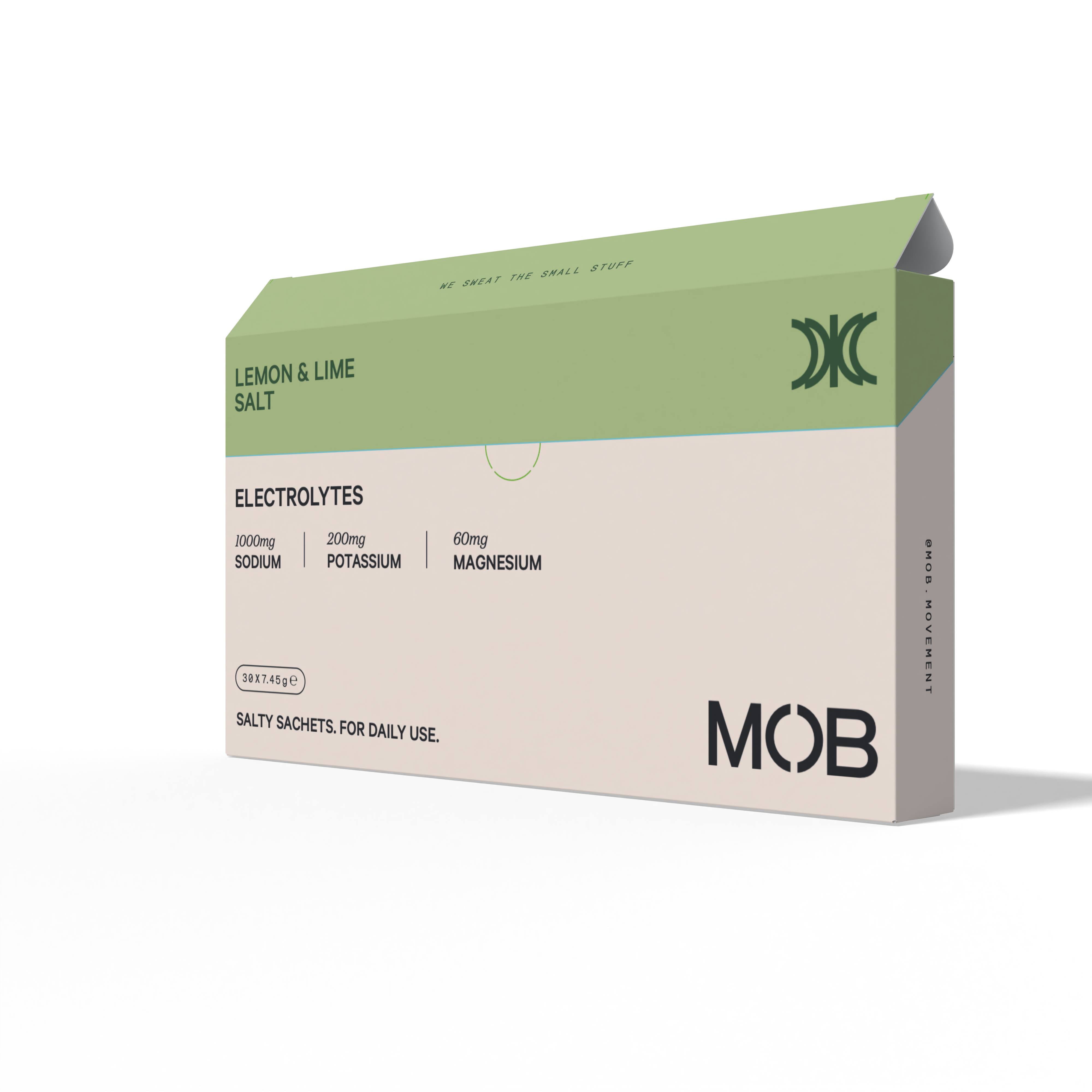Electrolyte drinks aren’t all created equal. The right formula is about more than throwing sodium and sugar into water. It’s about understanding how minerals work together in the body, how much you actually lose through sweat, and how to replenish those losses without overloading your system.
MOB Electrolytes are built around that balance. In this article, we look at the science behind electrolyte formulation — why ratios matter, how different minerals support each other, and what sets an effective hydration product apart from the rest.
Why Electrolytes Work Better Together
Electrolytes like sodium, potassium, and magnesium are interdependent. They regulate fluid balance by moving water into and out of cells, enable nerve impulses, and control muscle contractions (Institute of Medicine 270–72). An imbalance in one can disrupt the others.
-
Sodium is the primary extracellular ion, pulling water into the bloodstream and supporting overall fluid balance (Baker).
-
Potassium works inside the cell, balancing sodium’s effects and preventing excessive water retention or loss (Sawka et al. 379).
-
Magnesium plays a supporting role, regulating muscle relaxation and energy production while stabilising nerve signals (Lukaski 305–07).
A formulation that focuses heavily on one mineral at the expense of others can actually impair hydration rather than improve it.
Getting the Ratios Right
Sweat contains a higher concentration of sodium compared to potassium or magnesium. Sodium losses can range anywhere from 220 to 2,000 mg per litre of sweat, while potassium and magnesium are lost in smaller but still meaningful amounts (Baker). This means sodium typically requires the highest replenishment, but not in isolation.
Research shows that balanced sodium-potassium replacement supports better fluid retention and nerve-muscle communication during exercise (Sawka et al. 377–80). Magnesium, while lost in smaller amounts, contributes significantly to muscle recovery and neuromuscular efficiency, especially in individuals with lower dietary intake (Lukaski 305–07).
Why MOB’s Formula Hits the Sweet Spot
MOB Electrolytes are formulated to reflect real-world sweat losses — 1000 mg sodium, 200 mg potassium, and 60 mg magnesium. This ratio ensures proper hydration and supports both performance and recovery, without tipping into extremes like overly salty mixes or sugar-heavy sports drinks.
Unlike many electrolyte products, MOB also contains just one gram of dextrose. This small amount of sugar isn’t about energy spikes; it’s about function. Dextrose helps accelerate sodium and water absorption in the small intestine via the sodium-glucose co-transport mechanism (Sawka et al. 378). In other words, a little sugar actually helps electrolytes work better — and one gram keeps the formula effective without being overly sweet or calorie-dense.
Avoiding the Extremes
Electrolyte products often fall into two camps: sugar-heavy sports drinks or minimalist “hydration boosters” with very low sodium. Both can miss the mark.
-
Drinks with too much sugar may deliver energy but slow fluid absorption and cause stomach discomfort during exercise.
-
Formulas with too little sodium may fail to replace what’s lost in sweat, leading to poor rehydration and an increased risk of cramps or hyponatremia (Maughan et al. 590).
MOB is deliberately positioned between these extremes. Enough sodium to address real sweat losses, paired with potassium and magnesium for balance, and only a trace of sugar to improve absorption — not dominate the formula.
Conclusion
Developing MOB wasn’t about guessing. It was the result of months spent researching sweat science, mineral interactions, and how the body performs and recovers under stress. We studied sodium-potassium ratios, magnesium’s role in neuromuscular control, and how small amounts of sugar improve absorption without overloading the body.
But we didn’t stop at electrolytes. MOB also includes B-vitamins (B2, B3, B5, and B12), which support energy metabolism and help reduce tiredness and fatigue — especially when the nervous system is under strain from heat, movement, or daily stress (Institute of Medicine 340–43). We added Siberian ginseng, an adaptogen studied for its ability to help maintain mental performance during fatigue and improve resilience under physical load (Davydov and Krikorian 54–56).
The result is a formula that does more than replace what you lose through sweat. It supports the systems behind your movement — energy, focus, and recovery — without the excess sugar or filler common in many hydration products. Balanced minerals, functional doses, and evidence-based extras: that’s the science behind MOB.
Works Cited
Baker, L. B. “Sweat Sodium Concentration and Sodium Loss in Athletes.” Gatorade Sports Science Institute, 2017. https://www.gssiweb.org/sports-science-exchange/article/sse-161-sweat-testing-methodology-in-the-field-challenges-and-best-practices.
Institute of Medicine. Dietary Reference Intakes for Water, Potassium, Sodium, Chloride, and Sulfate. National Academies Press, 2005.
Institute of Medicine. Dietary Reference Intakes for Thiamin, Riboflavin, Niacin, Vitamin B6, Folate, Vitamin B12, Pantothenic Acid, Biotin, and Choline. National Academies Press, 1998.
Lukaski, Henry C. “Magnesium, Zinc, and Chromium Nutrition and Athletic Performance.” Sports Medicine, vol. 10, no. 5, 1990, pp. 303–10. https://doi.org/10.2165/00007256-199010050-00002.
Maughan, R. J., Shirreffs, S. M., and Leiper, J. B. “Errors in the Estimation of Hydration Status from Changes in Body Mass.” British Journal of Sports Medicine, vol. 41, no. 8, 2007, pp. 590–91. https://bjsm.bmj.com/content/41/8/590.
Davydov, M., and R. Krikorian. “Eleutherococcus senticosus (Siberian Ginseng) as an Adaptogen: A Review of Clinical Data.” Journal of Ethnopharmacology, vol. 72, no. 3, 2000, pp. 345–393. https://doi.org/10.1016/S0378-8741(00)00224-9.
Sawka, Michael N., et al. “Exercise and Fluid Replacement.” Medicine & Science in Sports & Exercise, vol. 39, no. 2, 2007, pp. 377–90. https://doi.org/10.1249/mss.0b013e31802ca597.








